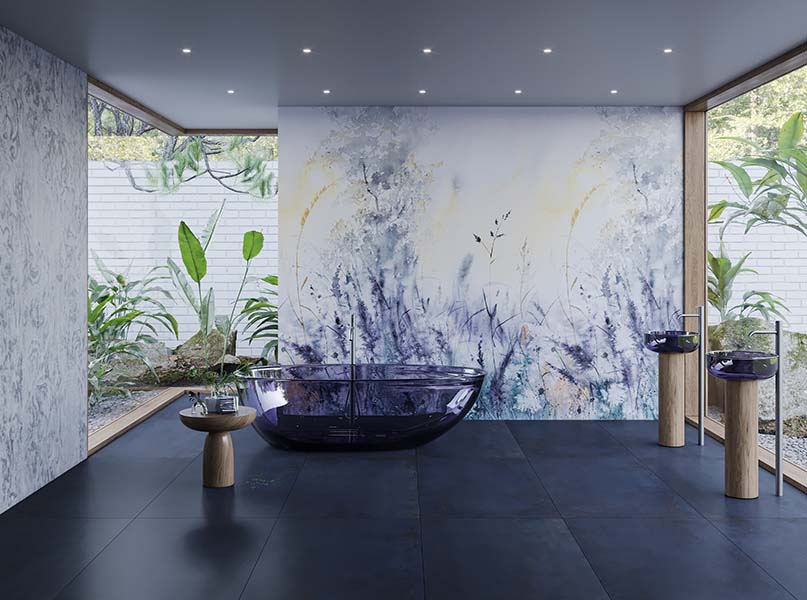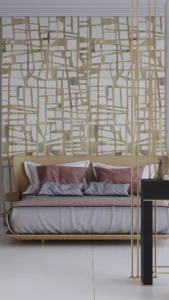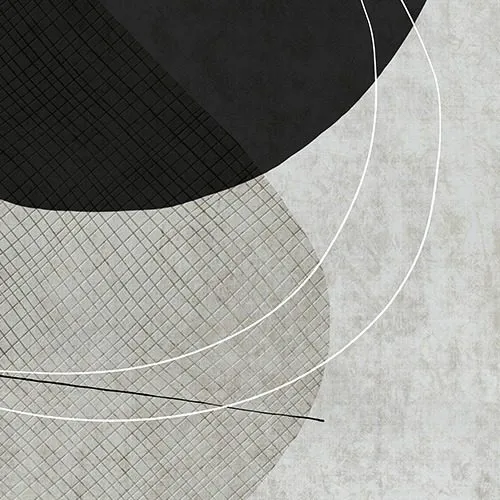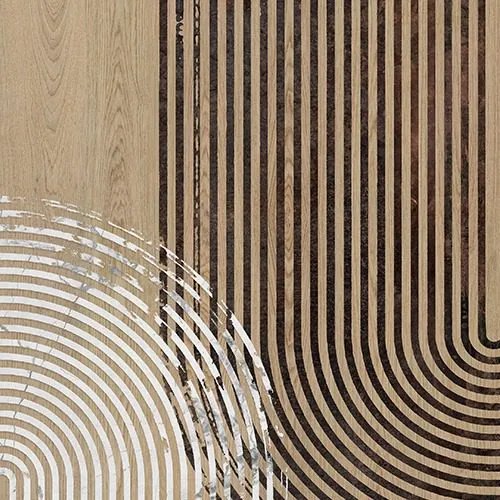Decorative Accent Wall Porcelain Slabs are a special category of ceramic tile slabs that showcase intricate designs, patterns, and motifs. Unlike standard tiles, which are primarily chosen for their practicality, porcelain decorative slabs emphasize aesthetics and artistic expression. These tiles come in various shapes, sizes, and styles, allowing individuals to create unique and personalized spaces.
Decorative porcelain Tiles and Slabs have not only adorned functional spaces but also played a crucial role in art and architectural expression. Throughout history, Decorative Porcelain Tiles have been used in palaces, temples, mosques, and public buildings to convey cultural, religious, and historical narratives. European craftsmen and artists began producing highly detailed and ornamental tiles for palaces, churches, and wealthy households. In Islamic architecture, decorative tiles, known as "Iznik tiles" in Turkey and "Zellige" in North Africa, are used to embellish mosques and other sacred structures. These tiles feature geometric patterns, arabesques, and calligraphy, reflecting the Islamic principles of order, symmetry, and spirituality.
Today, the tradition of decorative porcelain tiles continues to thrive, with contemporary artists and manufacturers pushing the boundaries of creativity and technology. From ornate murals and intricate mosaics to contemporary abstract designs, decorative porcelain tiles can transform any room into a work of art. In addition to their visual appeal, decorative porcelain tiles retain the durability and practicality that porcelain tiles are known for, making them suitable for both residential and commercial applications. Decorative porcelain tiles are highly sought after in the UAE, particularly in cities like Sharjah, Abu Dhabi, and Dubai.
.

Manufacturing Process
The manufacturing process of decorative porcelain slabs is similar to that of standard porcelain tiles but with an added emphasis on design and aesthetics. Decorative porcelain tiles can be created using various techniques to achieve intricate designs:
Large-format Decorative Porcelain Tiles
Porcelain Tiles and Slab Products are gaining popularity for their ability to create seamless and immersive designs. Decorative Porcelain Slab Tiles eliminate the need for numerous grout lines, resulting in a clean and contemporary look.
Printing
Digital printing technology allows for the precise reproduction of complex patterns and motifs on porcelain tiles. High-resolution images are transferred onto the tile surface, capturing fine details and gradations in color.
EVODRY technology: EVODRY excels in applying materials like glass grit onto ceramic substrates, creating mesmerizing effects such as veins, contrasts, textures, and structures.
Embossing: Embossing involves adding relief to the tile's surface, creating a three-dimensional effect.
[caption id="attachment_2813" align="alignnone" width="600"]
 Aximer Ceramic Decorative Accent Wall Porcelain Slab Called VIVA[/caption]
Aximer Ceramic Decorative Accent Wall Porcelain Slab Called VIVA[/caption]
Advantages of Decorative Porcelain Tiles & Slabs
Decorative porcelain slabs offer numerous advantages that make them a favored choice for designers and homeowners:
Aesthetic Appeal
The primary advantage of decorative porcelain tiles is their exceptional visual appeal. These tiles can add character, charm, and elegance to any space, creating a captivating and inviting atmosphere.
Timeless Elegance
Decorative porcelain tiles possess a timeless quality that transcends passing trends. They can complement various design styles, from classic and traditional to modern and contemporary, ensuring their relevance for years to come.
Versatility
Decorative porcelain tiles come in various styles and designs, allowing for endless creative possibilities. From traditional and classic patterns to modern and contemporary motifs, there is a decorative tile to suit every design preference.
Water resistance
Decorative porcelain tiles are suitable for areas with high humidity or moisture, such as bathrooms and kitchens, as they do not absorb water like wallpaper, preventing mold and mildew growth.
Durability
Decorative porcelain tiles are highly durable and resistant to scratches, stains, and moisture, making them a durable option compared to other decorative materials such as wallpaper, which are easily torn or damaged.
Impact resistance
Unlike paint or wallpaper, decorative porcelain tiles can withstand accidental impacts without damage, making them more suitable for high-traffic areas or homes with children and pets.
Easy Maintenance
Decorative porcelain tiles are easy to clean and maintain, requiring simple regular care to preserve their beauty and luster.
Customization
With advancements in digital printing technology, it is now possible to customize decorative porcelain tiles with unique designs, colors, and patterns. This level of personalization allows for one-of-a-kind creations tailored to specific design visions.
Investment Value
Decorative porcelain tiles not only add value to the aesthetics of a property but also enhance its overall market appeal. These tiles can be considered an investment in the long-term appeal and value of a space.

Applications of Decorative Porcelain Tiles
Decorative porcelain tiles can be used in various interior and exterior applications to enhance the beauty and character of a space. Here are some common applications:
Backsplashes and Countertops
Decorative porcelain tiles can be used to create eye-catching backsplashes in kitchens and bathrooms. They serve as a focal point, elevating the entire space. Additionally, decorative tiles can be applied to countertops, providing an artistic and durable surface.
Decorative Accents and Borders
Decorative tiles can be used as accents or borders alongside standard tiles. This adds a touch of interest and flair to otherwise simple tile installations. Borders of decorative tiles can frame a room or delineate different areas within a space.
Interior Flooring and Walls
Decorative porcelain tiles are an excellent choice for both flooring and accent wall coverings in interior spaces. They add personality and charm to living rooms, bedrooms, kitchens, bathrooms, and entryways. The versatility of decorative tiles allows for the creation of unique and visually striking floor and wall designs.
Exterior Facades and Pathways
Decorative porcelain tiles are not limited to indoor use; they can also be applied to exterior facades and pathways. Decorative tiles can transform the exterior of a building, creating a unique and welcoming façade. In garden spaces or outdoor patios, decorative tiles can be used to create beautiful pathways or embellish walls.
Styles and Designs
Decorative porcelain tiles offer an extensive array of styles and designs to suit diverse tastes and preferences. From classic and traditional to modern and contemporary, decorative tiles can transform any space into a unique and visually stunning environment. Here are some popular styles and designs
Geometric and Abstract Motifs
Geometric patterns, such as chevrons, hexagons, and herringbone, are popular choices for decorative tiles. These patterns can be arranged in various layouts and color combinations to create a dynamic and visually engaging surface.
Floral and Nature-inspired Themes
Nature has long been a source of inspiration for decorative tiles. Floral motifs, botanical prints, and depictions of landscapes or wildlife are frequently used to bring the beauty of the outdoors inside.
Classic and Traditional Patterns
Decorative porcelain tiles often draw inspiration from historical ceramic traditions. Classic motifs such as arabesques, damask patterns, and floral designs are commonly found in decorative tiles. These timeless patterns add a touch of elegance and sophistication to interiors.
Modern and Contemporary Designs
For those seeking a more contemporary aesthetic, modern decorative tiles offer a plethora of options. Minimalist geometric patterns, abstract art-inspired designs, and clean lines characterize modern decorative tiles, allowing for a sleek and stylish ambiance.
Artistic Murals and Mosaics
Decorative porcelain tiles can be assembled into large murals or intricate mosaics, showcasing elaborate scenes, portraits, or narrative depictions. These artistic installations serve as focal points and add a touch of drama and creativity to spaces.
Combining Decorative Porcelain Tiles with Other Materials
One of the strengths of decorative porcelain tiles is their ability to complement and harmonize with other materials, creating visually engaging and multi-textured surfaces. Here are some examples of how decorative porcelain tiles can be combined with other materials:
Creating Contrast with Glass
When combined with glass elements, decorative porcelain tiles can create an intriguing interplay of textures and reflections. Glass tiles with metallic accents can be used as borders or accents alongside decorative tiles, adding a touch of luxury and luminosity.
Complementing Wood and Metal
Decorative tiles can be paired with wood and metal elements to achieve a balance of warmth and sophistication. For instance, a kitchen backsplash featuring decorative tiles harmonizes beautifully with wooden cabinetry and metal fixtures.
Mixing with Natural Stone
Decorative porcelain tiles can be combined with natural stone to create captivating contrasts. For example, a decorative tile mural placed alongside a stone-clad fireplace adds depth and interest to the space.
Inspiring design ideas for choosing suitable decorative porcelain tiles
For Inspiring design ideas for choosing the suitable decorative porcelain slab, Selecting suitable porcelain slabs involves considering various factors, including the style of the space, the desired ambiance, and practical considerations. Here are some guidelines to help in the decision-making process:
Considerations for Interior Design
Theme and Style
Determine the overall theme and style of the space. Decide whether you want a classic, contemporary, or eclectic ambiance to guide your choice of decorative tiles.
Color Palette
Consider the color scheme of the room and select decorative tiles that complement or contrast with the existing colors. Harmonious color choices will create a seamless and unified look. For example, in a bathroom, use decorative porcelain tiles to design a harmonious pattern on the shower walls. Opt for a combination of geometric and floral motifs to create a unique and captivating shower space.
Incorporating Decorative Tiles in Various Spaces
In a kitchen, use decorative tiles as a backsplash to bring artistic flair to the culinary space. Choose a mosaic of decorative tiles that complements the kitchen's color scheme and overall design theme.
Size and Proportion
Consider the size of the space and the proportion of the decorative tiles to ensure a balanced and visually appealing result. Larger rooms can accommodate larger decorative tiles, while smaller spaces may benefit from smaller patterns.
Placement and Focal Points
Identify the areas where you want to install decorative tiles as focal points. Choose designs that draw attention to these specific areas and create a sense of visual interest. For example, in a living room, create a stunning focal point by applying a decorative porcelain tile mural on the fireplace wall. The intricate design and vibrant colors draw attention and add personality to the space.
Lighting
Consider the lighting in the space. Decorative tiles with reflective surfaces or metallic accents can enhance the effects of natural and artificial lighting.

Factors for Exterior Applications
Climate and Weather Resistance
Ensure that the decorative porcelain slabs selected for exterior applications are suitable for the local climate and can withstand exposure to sunlight, rain, and temperature fluctuations. you can read a more detailed article about Decorative Porcelain Slabs and Dubai's Climate Conditions in our blog section.
Slip Resistance
For outdoor areas prone to moisture, such as patios and pool decks, opt for decorative tiles with slip-resistant surfaces to ensure safety.
Fade Resistance
Choose decorative tiles that are resistant to fading caused by UV exposure. This ensures the designs remain vibrant and do not lose their allure over time.
Aximer Ceramic, the Best Decorative Accent Wall Porcelain Tile & Slab Supplier in Dubai
Aximer Ceramic offers a diverse collection of decorative ceramics with a variety of colors and models. They have categorized their designs into five main groups, namely Minimal, Golden, Classic, Painting, and Flower Design, to make it easy for customers to find what they are looking for. Aximer Ceramic is a leading supplier of decorative ceramic tiles from around the globe, with a particular focus on Spain and Italy. We are based in Dubai and committed to bringing you the best in quality and design.
Discover More About Porcelain Tiles and Slabs and Their Features
Explore our dedicated article and guides on Porcelain Tiles Properties, Advantages, and Applications, for further insights and inspiration in our Blog Section.
Frequently Asked Questions about Decorative Porcelain Tiles
How to Clean Decorative Porcelain Tiles?
Cleaning decorative porcelain tiles is relatively simple. Regularly sweep or vacuum the surface to remove dirt and debris. Use a mild soap or tile cleaner mixed with water to clean the tiles, and avoid abrasive cleaners that may scratch the tile surface. Rinse the tiles thoroughly and dry them with a soft cloth to prevent water spots.
Can Decorative Tiles be Used in Wet Areas?
Yes, decorative porcelain tiles are suitable for wet areas such as bathrooms and kitchens. Porcelain tiles are water-resistant and easy to clean, making them an ideal choice for these spaces. To prevent slip accidents, consider using decorative tiles with a slip-resistant surface in wet areas.
Are Decorative Porcelain Tiles Durable?
Yes, decorative porcelain tiles are highly durable and long-lasting. Porcelain tiles are fired at high temperatures, resulting in a dense and hard material that is resistant to wear, stains, and scratches. Properly installing and maintaining decorative porcelain tiles can retain their beauty for many years.




